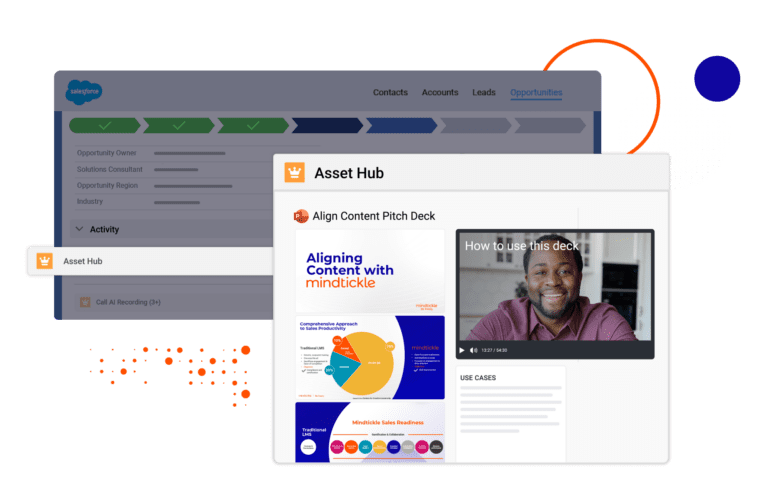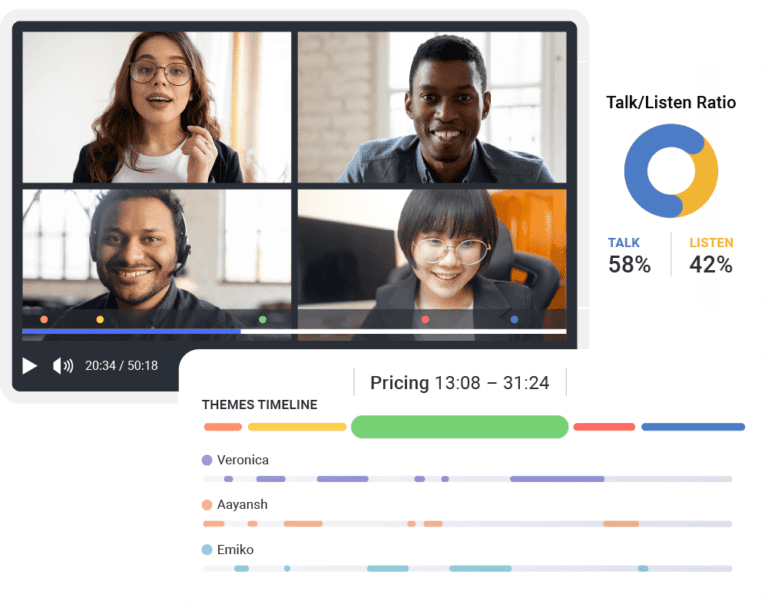Great sales reps must know their product and service offerings inside and out. That way, they can confidently recommend solutions that’ll address their prospects’ biggest challenges and pain points.
But it’s equally important for reps to be well-versed in how their company stacks up against the competition. This knowledge is especially important to winning competitive deals, which are quite common. According to Semrush, over half (57%) of all sales deals are competitive.
Sales battlecards (also referred to as competitive intelligence battlecards, sales enablement battlecards, or simply battlecards) are one tool winning sales organizations use to ensure their sellers are always ready to conquer any competitive deal.
In this post, we’ll explore what sales they are, why they’re important, and how sales organizations can create effective ones to improve seller performance and close more deals.
What are sales battlecards?
Sales battlecards are an effective tool for ensuring reps are experts on their competitors’ offerings. But what are sales battlecards?
They provide an overview of how your company stacks up against the competition. Sales battlecards distill key factors about your own company and your competitors, which may include:
Products
Services
Features + functionality
Pricing
A sales battlecard may compare your company to a single competitor. For example, HubSpot might create one comparing their marketing automation offering to that of ActiveCampaign.
Other sales battlecards compare a company against multiple competitors. For example, a multi-competitor one might show how HubSpot stacks up against ActiveCampaign, Mailchimp, Salesforce Marketing Cloud, and Marketo Engage.
Some sales battlecards are created as an internal resource for sellers to use. Others are developed as customer-facing collateral. We’ll explore the different types later on.
How are sales battlecards important for competitive selling?
Creating battlecards takes time. Is it really worth the effort?
Yes, without a doubt.
Competitive intelligence battlecards are a powerful tool for competitive selling. In fact, they’re proven to improve sales outcomes. According to research from Crayon, seven in 10 businesses that use them say they’ve boosted their win rates.
Competitive knowledge is key to sales success. But sales reps are busy people. They simply don’t have the time to keep up with every product or feature change announced by a competitor. Sales battlecards can help bridge the gap.
Here’s how battlecards help reps during the course of a deal:
Product and service offerings are always changing and evolving. Competitive intelligence battlecards help ensure sellers always have the latest information about their competitors – and how their own offerings stack up. However, it’s essential they’re updated on a regular basis.
One-size-fits all pitches don’t work. Instead, sellers must develop pitches that address the unique needs and challenges of each seller.
In some cases, a sales rep knows which competitors a prospect is considering. Sales battlecards can help reps tailor their pitches in a way that addresses how their offerings are a better solution than what the competition has to offer.
Sellers are no strangers to objections. A recent analysis found that 63% of sales calls have more negative sentiment than positive. Competitive mentions are one example of negative sentiment.
As such, objection handling is a key sales skill. Specifically, reps must be prepared to address objections related to competitors.
Imagine a prospect considering two competing products. They might raise objections such as:
- Why does the competitor’s product have these features – and yours doesn’t?
- Why are these product features important when your competitors don’t have them?
- Why is the competitor’s product less expensive?
Battlecards help sellers understand how their offerings stack up against a competitor. That way, they can anticipate buyers’ objections – and be equipped to address them head-on.
What are the types of sales battlecards?
There are many different types of sales battlecards. Each type is used in different circumstances.
Single competitor vs. multi-competitor
You might develop a sales battlecard that compares your business to one competitor. These can be a great resource for sellers who are working with prospects who are further along in the sales funnel and have shared what other options they are considering. These single-competitor sales battlecards provide a detailed look at a competitor’s strengths and weaknesses.
Some organizations also develop a sales battlecard that pits the company against multiple competitors. They can be a great resource for reps when they’re working on deals that are higher up in the sales funnel. Typically, they include less detail than a single competitor battlecard.
Competitive
Competitive battlecards provide information on a company’s key competitors. This information might include:
- Company information
- Product and service information
- Pricing
- Target audience
They are a great resource for ensuring sales reps know how your company stacks up. Competitive battlecards also help sellers anticipate objections so they can be prepared to address them.
Product
These ensure sales reps know the ins and outs of the products they’re selling. These battlecards may incorporate information including:
- Customer challenges
- How the product helps address these challenges
Some product battlecards focus on a single product offering. Others compare multiple product offerings – and how they each address specific use cases.
Marketing
Marketing battlecards focus on the marketing strategies of key competitors. These zero in on who the competition is marketing to and what strategies they’re using to position themselves as the right choice for that market.
For example, one competitor may position themselves as the lowest-cost option. If your solutions are more expensive, your reps must be prepared to articulate why that is the case.
Marketing battlecards may also incorporate other information on competitors’ marketing strategies, including:
- Strategic partners
- Key marketing channels
Prospect-specific sales
Some battlecards can be used more generally. For example, a multi-competitor, customer-facing sales battlecard can provide a great overview of how your company differs from its key competitors.
However, there are times when it makes sense to create a prospect-specific sales battlecard. This sales enablement battlecard can address the specific, unique pain points of the prospect – and how your solutions stack up to your competitors in terms of solving those pain points.
How to create effective sales battlecards
Sales battlecards are a great resource for your reps. They can have a positive impact on sales outcomes – when they’re thoughtfully created and your sales reps know how to use them.
So, how exactly should you go about creating one? Here are a few best practices to guide the process.
Start with a template
Determine your competitors
Chose your focus areas
Do your research
Revisit them often
Start with a template
Starting your sales battlecard from scratch can seem overwhelming. Instead, consider starting with template that suits your needs and use case. Using a template will save time – and it’ll help ensure they all have a consistent look and feel.
Remember: a template should only be a starting place. Be sure to adapt the template as needed so it works for your needs.
Choose your competitors
Start by making a list of your key competitors. Then, add details about how often and when each one typically comes up in the sales process. If you’re not sure, ask for insights from those who know best: your sales team.
These insights can help you determine what type is needed for each competitor. For example, if your sellers often lose deals to a specific competitor, it makes sense to develop a battlecard focused solely on that competitor. However, if there is another competitor that’s brought up earlier in the purchase journey – but you don’t often lose deals to them – you can include them in a multi-competitor sales battlecard.
Determine your sales battlecard focus areas
Next, you’ll need to determine the categories to include in your sales enablement battlecard. Some focus areas to consider are:
- Product features
- Cost
- ROI
- Customer support
- Customization options
The focus areas of your sales battlecard will depend on the type you’re developing and the intended audience. For example, a customer-facing multi-competitor battlecard will likely include fewer focus areas than an internal, single competitor version.
Of course, you want to develop battlecards that put your brand and offerings in the best light. However, it’s important to be honest, too. If there’s an area where a competitor outshines you, be sure your sellers know how to articulate why this is the case.
Do your research
It’s important to ensure the information on your sales battlecards is accurate. If a prospect notices an error, you’ll lose your credibility – and likely, the sale.
As such, it’s important to do plenty of research when developing your them. Much of your research can be done online. For example, you can find product feature information on your competitors’ websites. In addition, you can read reviews from current and past customers to gain insight into user experience. A generative AI tool like ChatGPT can also be a great tool for doing high-level research about competitors.
In addition, ask for feedback from teams throughout the organization. For example, the sales team can provide insight into why deals are often lost to a specific customer. Marketing teams, on the other hand, likely have insight into a competitor’s online presence and marketing strategy.
Revisit them regularly
Sales battlecards aren’t a one-time project. Instead, they need to be revisited often.
Why? Your own products and features will change and evolve in the future. So will that of your competitors.
It’s important to ensure they always reflect the latest and greatest information about your own business as well as your competitors. That way, your sales reps can confidently share their knowledge and be equipped to overcome objections.
How to use them
Creating great battlecards is foundational. But it’s also important to ensure your sales reps know they exist and how to use them. Otherwise, the time and effort spent creating them will be wasted.
With that in mind, here are a few best practices for using them.
Do's
Don'ts
- Store your them in a single location
- Provide training, enablement, and coaching on how to use them
- Ensure sellers know which ones are internal and which are customer-facing
- Leverage conversation intelligence to ensure sellers are putting their knowledge into practice in the field
- Communicate when a new one is available
- Welcome feedback – especially from top sellers – and incorporate this feedback into new versions
- Distribute them via email or store via disparate platforms
- Assume sellers know how to use sales them
- Distribute internal sales battlecards to prospects
- Assume sellers are applying their competitive knowledge in the field
- Make your reps find them on their own
- Create the sales battlecards once and never revisit
#1: Ensure they are centrally located and easily accessible
Some sales organizations may still use printed sales battlecards. But most have made the transition to digital sales enablement battlecards. It’s important to ensure they are housed in a central location so your sales reps know exactly where to find them.
Some organizations opt to store them in Google Drive, Microsoft OneDrive, or a similar solution. However, a better approach is to store your sales battlecards within your revenue enablement platform. That way, sales reps can easily find exactly what they’re looking for – anytime and from any device.
In addition, a sales productivity tool with content management capabilities makes it easy to make updates to them. That means your sales reps can always access the latest and greatest versions of each sales one. You no longer have to worry about them using an outdated sales versions.
Empower your sellers to win more competitive deals
Sales reps must have deep knowledge of their own products. But they must also become experts on their competitors’ offerings.
Sales battlecards are a great resource for both new and veteran sellers. They provide reps with the information they need to confidently articulate how they differ from the competition. They also help sellers anticipate buyers’ objections – and ensure they’re ready to overcome those objections.
The best place to house your sales battlecards is within a revenue intelligence platform like Mindtickle. That way, your sales teams can access the sales training, sales enablement, sales content, and conversation intelligence they need to win against the competition – all in one place.

#2: Provide enablement and coaching on how to use them
You’ve created a collection of sales battlecards. But you shouldn’t assume your sellers know what to do with them.
It’s important to provide sales training, sales enablement, and coaching to ensure your reps know how and when to use the sales battlecards available to them. Training, bite-sized exercises, and practice opportunities can help ensure sellers understand:
- Which ones are available to them
- The intended audience for each one (internal vs. external)
- Which ones they should use in which sales scenarios
Sales managers can also leverage conversation intelligence to ensure sales reps are actually putting their knowledge into practice in the field. If there are knowledge gaps, sales managers can provide additional coaching to close those gaps – and improve sales outcomes.


#3: Communicate when there are new ones available
Over time, there may be a need to create additional versions. Each time a new one is available, make sure to let the sales team know. That new sales battlecard may just be the ticket to winning their next competitive deal.
#4: Ask for feedback
Your customer-facing teams interact with prospects day in and day out. They’re well aware of your key competitors and why they’re losing deals to them. So be sure to ask for their feedback on a regular basis. Incorporating feedback from your top sales reps can help improve the effectiveness of your sales battlecards.
Empower your sellers to win more competitive deals
Sales reps must have deep knowledge of their own products. But they must also become experts on their competitors’ offerings.
Sales battlecards are a great resource for both new and veteran sellers. They provide reps with the information they need to confidently articulate how they differ from the competition. They also help sellers anticipate buyers’ objections – and ensure they’re ready to overcome those objections.
The best place to house your sales battlecards is within a revenue intelligence platform like Mindtickle. That way, your sales teams can access the sales training, sales enablement, sales content, and conversation intelligence they need to win against the competition – all in one place.
Close every winnable deal
Want to see firsthand how Mindtickle prepares your sales teams to beat the competition?
Request a Demo






